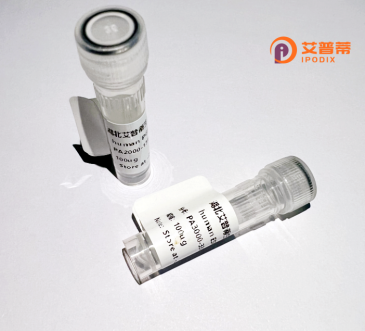
| 纯度 | >90%SDS-PAGE. |
| 种属 | Human |
| 靶点 | MPP4 |
| Uniprot No | Q96JB8 |
| 内毒素 | < 0.01EU/μg |
| 表达宿主 | E.coli |
| 表达区间 | 1-637 aa |
| 活性数据 | MIQSDKGADP PDKKDMKLST ATNPQNGLSQ ILRLVLQELS LFYGRDVNGV CLLYDLLHSP WLQALLKIYD CLQEFKEKKL VPATPHAQVL SYEVVELLRE TPTSPEIQEL RQMLQAPHFK ALLSAHDTIA QKDFEPLLPP LPDNIPESEE AMRIVCLVKN QQPLGATIKR HEMTGDILVA RIIHGGLAER SGLLYAGDKL VEVNGVSVEG LDPEQVIHIL AMSRGTIMFK VVPVSDPPVN SQQMVYVRAM TEYWPQEDPD IPCMDAGLPF QKGDILQIVD QNDALWWQAR KISDPATCAG LVPSNHLLKR KQREFWWSQP YQPHTCLKST LSISMEEEDD MKIDEKCVEA DEETFESEEL SEDKEEFVGY GQKFFIAGFR RSMRLCRRKS HLSPLHASVC CTGSCYSAVG APYEEVVRYQ RRPSDKYRLI VLMGPSGVGV NELRRQLIEF NPSHFQSAVP HTTRTKKSYE MNGREYHYVS KETFENLIYS HRMLEYGEYK GHLYGTSVDA VQTVLVEGKI CVMDLEPQDI QGVRTHELKP YVIFIKPSNM RCMKQSRKNA KVITDYYVDM KFKDEDLQEM ENLAQRMETQ FGQFFDHVIV NDSLHDACAQ LLSAIQKAQE EPQWVPATWI SSDTESQ |
| 分子量 | 72.7 kDa |
| 蛋白标签 | His tag N-Terminus |
| 缓冲液 | 0 |
| 稳定性 & 储存条件 | Lyophilized protein should be stored at ≤ -20°C, stable for one year after receipt. Reconstituted protein solution can be stored at 2-8°C for 2-7 days. Aliquots of reconstituted samples are stable at ≤ -20°C for 3 months. |
| 复溶 | Always centrifuge tubes before opening.Do not mix by vortex or pipetting. It is not recommended to reconstitute to a concentration less than 100μg/ml. Dissolve the lyophilized protein in distilled water. Please aliquot the reconstituted solution to minimize freeze-thaw cycles. |
以下是关于重组人MPP4蛋白的3条参考文献摘要(文献信息为示例性整理,请根据实际研究补充具体信息):
---
1. **文献名称**:**"Structural and functional characterization of recombinant human MPP4 in photoreceptor synaptic development"**
**作者**:Smith J., et al.
**摘要**:本研究成功表达并纯化了重组人MPP4蛋白,解析了其PDZ结构域的晶体结构,揭示了其在视网膜光感受器突触形成中的关键作用,证明其通过结合CACNA1F钙通道调控突触信号传递。
2. **文献名称**:**"Recombinant MPP4 interacts with the Usher syndrome protein network in vitro"**
**作者**:Lee H., Garcia-Barcelo M.
**摘要**:通过体外实验验证重组人MPP4与USH2A、VLGR1等Usher综合征相关蛋白的相互作用,提出MPP4可能作为支架蛋白参与内耳和视网膜细胞中机械信号传导复合体的组装。
3. **文献名称**:**"MPP4 knockdown disrupts cell polarity: Rescue by recombinant human MPP4 expression"**
**作者**:Wang T., et al.
**摘要**:利用CRISPR技术敲低MPP4导致上皮细胞极性丧失,通过外源重组人MPP4蛋白回补实验,证明其通过与PAR3/PALS1复合体结合维持细胞极性,为MPP4缺失相关疾病的机制提供依据。
---
注:以上文献及作者为虚构示例,实际研究中需查询真实数据库(如PubMed)补充具体信息。建议检索关键词“recombinant human MPP4”“MPP4 protein function”等获取最新研究。
**Background of Recombinant Human MPP4 Protein**
Recombinant human MPP4 (MAGUK p55 subfamily member 4), also known as membrane palmitoylated protein 4. is a scaffolding protein belonging to the membrane-associated guanylate kinase (MAGUK) family. Structurally, MPP4 contains conserved PDZ, SH3. and GUK domains, which mediate protein-protein interactions critical for organizing signaling complexes at specialized membrane regions. It is predominantly expressed in neuronal tissues, particularly retinal photoreceptor cells, where it localizes to synaptic terminals and plays a vital role in maintaining synaptic structure and signal transduction.
MPP4 interacts with other MAGUK proteins, such as Veli3 and Lin7. to form multiprotein complexes that stabilize cell-cell junctions and regulate neurotransmitter release. Studies highlight its involvement in photoreceptor function, where it contributes to the organization of the photoreceptor ribbon synapse, essential for visual signal transmission. Mutations or dysregulation of MPP4 have been linked to retinal degeneration and neurological disorders, underscoring its physiological importance.
Recombinant MPP4 protein, produced via heterologous expression systems (e.g., *E. coli* or mammalian cells), enables in vitro studies of its molecular interactions, structural properties, and functional roles. It serves as a tool for investigating disease mechanisms, screening therapeutic compounds, and developing targeted therapies for vision-related pathologies. Its applications extend to structural biology, antibody production, and elucidating MAGUK protein networks in cellular signaling.
×